Grow your own medicine with these medicinal plants
Part of taking charge of your health is knowing what herbal remedies you can use instead of those from modern medicine to treat minor health issues. Medicinal plants are a must for any self-sufficient home, as they are a way of ensuring that should you need it, you can use off-grid methods to take care of your health.
Whole plant remedies are more natural than synthetically derived medicines since often the active ingredient is isolated to create the medicine, and can lead to adverse reactions and side effects that wouldn’t occur if the entirety of the constituents had been left intact.
Growing medicinal plants to use in traditional remedies is even more empowering since you have cared for the plant and know where it came from and how it was cared for, harvested, and processed. In this article, we will explore 8 medicinal plants that you can grow in your own garden, how to grow them, and how they influence the systems of the body.
So let’s take a look at the 8 best medicinal plants you should start growing today.
Best medicinal plants for a self-sufficient home
1. Comfrey – Symphytum Officianalis
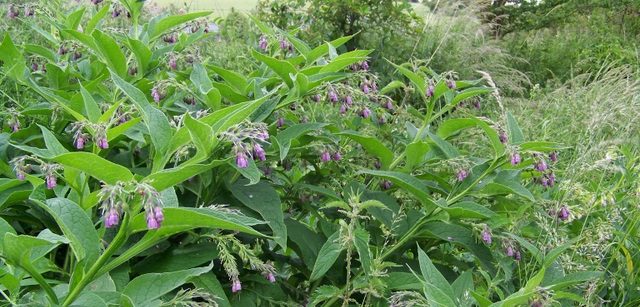
Comfrey (Symphytum officianalis), is a member of the borage family. It is a fast-growing, leafy perennial, hardy from USDA zones 3 to 9, and can fit into any size of a garden as it comes in multiple variations.
I have both the standard as well as a dwarf version in my garden. The dwarf version fits well in my front garden and the standard, larger size has a place in my back garden as well as my market garden. It has both medicinal as well as agricultural uses.
From a medicinal perspective, Comfrey is a healing herb. Mostly used topically in modern herbalism, it was traditionally taken internally to heal ruptured tissues and heal broken bones. Its traditional names include knitbone, and boneset. Even its Latin name, Symphytum (from the Greek symphis, meaning growing together of bones, and phyton, a plant), referring to its ancient uses. In French, its name is “consoude”, meaning to weld together.
Using Comfrey Internally – There are some concerns over using comfrey internally. It should not be taken in large amounts as it can toxify the liver. In addition, comfrey should not be used during pregnancy and lactation. Nor should it be given internally to infants or people with existing liver or kidney issues.
Using Comfrey Externally – Externally, comfrey is an excellent topical medicine to aid bruises, sprains, strains, and breaks. The leaves can be applied directly to the affected area and wrapped as a poultice. Processing it further can yield skin healing oils and salves. The gardener’s salve I produce for my market garden has comfrey as a primary ingredient.
Agriculturally, comfrey is a terrific fertilizer. The roots of the plant go incredibly deep in the soil and pull nutrients which it then stores in its leaves. The leaves can be cut (after the plant blooms), scattered in place, put in the compost pile or put in a muslin sack and immersed in water to make a comfrey tea which can be applied as a foliar spray or watered next to plants for a vitamin and mineral boost.
Growing Comfrey – Comfrey is easy to grow, I start mine from seed in seed trays, quickly moving them to larger pots with nutrient-rich soil until they grow up enough to be planted in the garden.
2. St. Johns Wort – Hypericum Perforatum
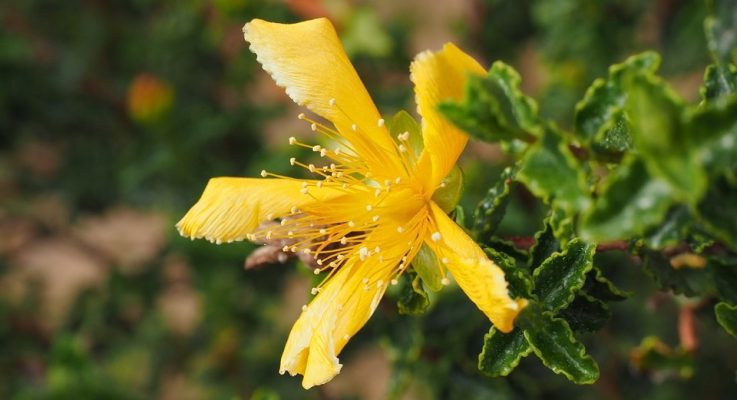
St. John’s Wort, or Hypericum perforatum, is a tender perennial (USDA Hardiness Zones 3-8) flowering plant. It is a beautiful medicinal splant that is very easy to grow. It is said that once you have St. John’s wort in your garden, you will always have it, although not always in the same spot you plant it.
A naturalized European plant, the initial spring growth is prostrate and spreading before it stands upright to flower. The one inch-yellow flowers have tiny black dots on the petal margins, these are oil glands; the leaves are covered with the same tiny oil glands.
Medical use – Medicinally, the astringent leaves are used on bites, bruises, and burns. Steeping the flowers and leaves in olive oil for a couple of weeks turns the oil red; this is used for wounds and earaches. The plant is antibacterial and anti-inflammatory. Contact with the plant may cause photodermatitis in sensitive individuals.
St. John’s Wort has been used and is currently being studied for use in those that suffer from depression. The extract has been known to provide mood elevation and stabilization, but significant study is still required. Some counterindication includes adverse reactions with some medications, including birth control pills, anti-anxiety medication and heart medications such as digoxin.
#3 Lemon Balm (Sweet Melissa) – Melissa Officinalis
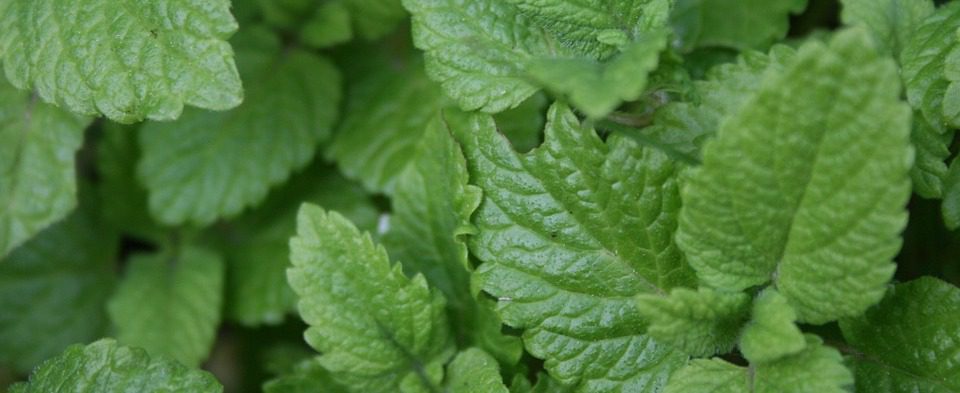
Lemon Balm is a fast growing, self-seeding perennial medicinal plant. It is a member of the mint family and has a multitude of medicinal and culinary uses.
Lemon Balm is easy to grow and it spreads very quickly so it is better suited in a raised bed or in pots if you are concerned about neighboring plants being overtaken.
Medicinal uses – Glossy bright green toothed leaves are repellant to mosquitoes; small white to cream flowers are a favorite of honey bees. It is used to attract them to new hives by rubbing the leaves on the inside of empty boxes.
It makes an outstanding beverage tea which reduces stress, soothes upset stomachs and headaches. In our market garden, we combine it with Lemon Verbena and Chamomile for a delightful summer iced tea.
4. Rosemary – Rosmarinus officinalis
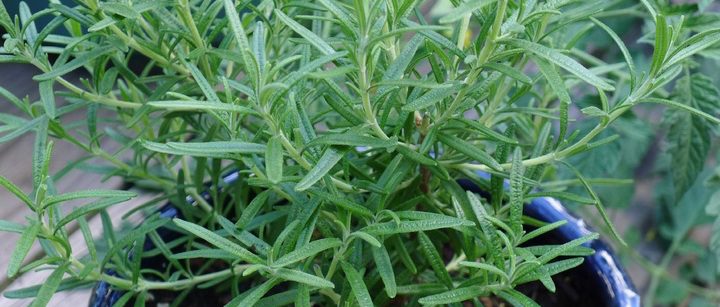
Rosemary, or Rosmarinus officinalis, is a tender annual in our zone (Zone 6a), but it is perennial in USDA Hardiness Zones 7 to 10.
Most Rosemary varieties are hardy down to the low 20’s F. A few – Arp, Salem, Hill Hardy – are reputedly hardy down to 0 F or below.
The key to overwintering outside is good drainage, some shelter from direct winter winds, and perhaps planting along a sidewalk or foundation to keep the roots a bit warmer. We pull our Rosemary in October into a small greenhouse or into the garage depending on the predicted winter conditions. We keep it lightly watered, but well drained. It is easier to grow from cuttings than from seed, but it is still possible to get the plant going from seed.
Native to the Mediterranean region, Rosemary has a long history of use in culinary as well as medicinal applications.
Medicinal benefits – It is said to increase the rate at which blood is supplied to body tissues and therefore to be good for the brain and memory. It was not uncommon to see Greek and Roman students wearing a garland or braid of rosemary in their hair, whilst studying for and taking exams. The volatile oil is a vasodilator and I use it in practice for migraine sufferers. It can be steeped in hot water and drunk as a tea or it can be tinctured in alcohol or glycerin and dosed from a dropper into water or tea.
It can be used with meat, fish, poultry, or game of any sort. Its piney aroma, dark green narrow leaves, and abundant blue flowers make it a most attractive herb, and a favorite of pollinators. The constituents of rosemary can block some of the carcinogenic concerns of grilled or charred meat. The oil in rosemary also helps block fat absorption when eaten with meat.
Herbalists have used rosemary for centuries to treat several skin complaints as well as a mood elevating and stabilizing tonic when feeling anxious, nervous or depressed.
5. Self Heal – Prunella vulgaris
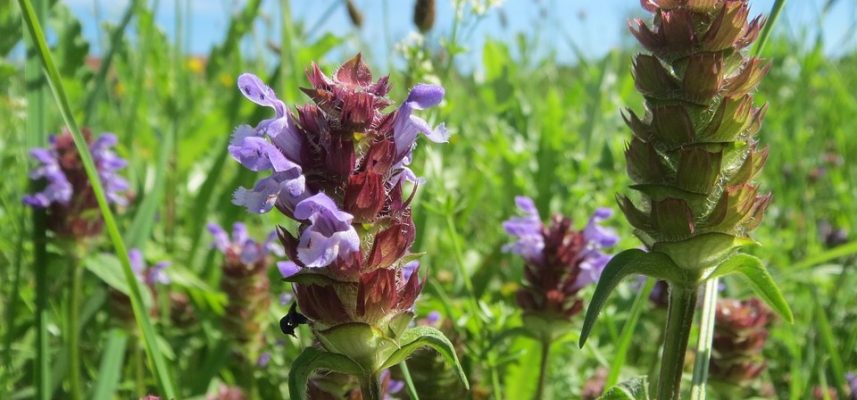
Prunella vulgaris is known to many as a common weed, but it is a valuable, natural healing medicinal plant.
In the horticulture world, several outstanding varieties have been selected and propagated for sale as perennial plants, but in most temperate climates, it grows wild. It starts out as a wide leafed plant, but then shoots a large plume of purple flowers which can be collected and infused in oil.
Medical uses – As its name indicates it has been widely employed as a healing herb. The leaves can be used as a poultice on pretty much every skin cut or eruption. It is often used as an astringent, styptic, and tonic. It is also known to aid in strengthening the heart and liver. It has also been traditionally used as an herbal remedy to treat diarrhea, high blood pressure, and fevers.
Additionally, it has an antibacterial action which inhibits the growth of pseudomas, E. Coli and Bacillus typhi and research studies are being conducted to see if this herb could be used to treat diabetes, AIDS, and cancer.
As an ointment, it has been used as an herbal remedy for eczema and psoriasis. It can also be used to treat bleeding hemorrhoids or swollen anal veins, vaginal pain, and inflammation.
An infusion of self-heal can be used as an eyewash to relieve tired, swollen eyes, and is reportedly effective as a treatment for conjunctivitis.
Self-heal can also be used as a mouth and throat wash; it soothes sore throats, and reduces swelling of the mouth, throat, and lymph nodes.
Finally, an infusion or tea of self-heal has traditionally been used as a folk remedy to treat anxiety, depression, and mood swings.
From a culinary perspective, the leaves are delicious and edible in soups, stews, and salads.
6. Horehound – Marrubium vulgare
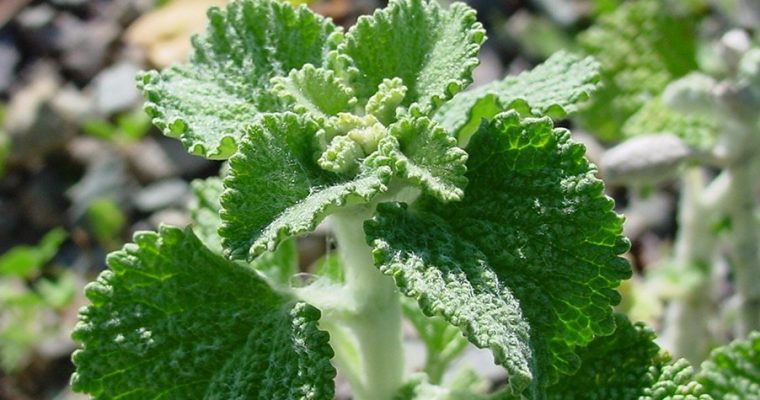
Horehound is a perennial plant, hardy in USDA Hardiness Zones 3-8.
It is very easy to grow, prefers dry soil, and as a member of the mint family, spreads rapidly so root barrier or container planting is recommended. The fuzzy leaves are used primarily and it produces barbed seed heads which stick to any and everything so caution should be taken when handling or when gardening around the plant.
There is no real culinary use for the plant; In its natural state, horehound has an unpleasant taste, but it can be masked by making it into a candy or a strong tea, sweetened with honey or sugar.
Medical uses – Horehound is an expectorant – useful in the treatment of coughs (including whooping cough), sore throats, bronchitis, asthma, tuberculosis, congestion and colds.
Horehound is also a natural remedy for digestion problems including loss of appetite, indigestion, bloating, gas, diarrhea, constipation, and liver and gallbladder complaints.
7. Wormwood –Artemisia absinthum & Southernwood – Artemisia abrotanum
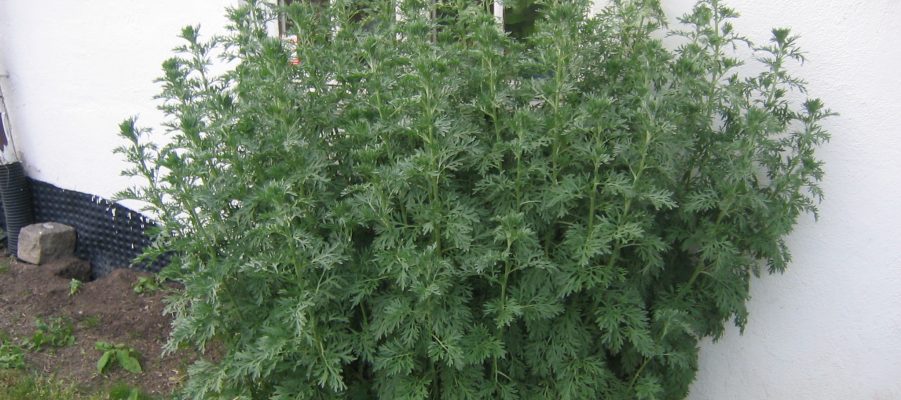
There are two varieties of wormwood that I keep in my garden, they are common Wormwood (Artemisia absinthum) and a variety called Southernwood (Artemisia abrotanum). These medicinal plants have a multitude of uses, from pest control, pollinator habitat as well as many medicinal uses. Hardy in USDA zones 4 to 8, these plants are very easy to grow, they grow fast and can get out of hand, so proper pruning and use of the leaves is important.
Medical uses – Wormwood has Intricately cut gray-green foliage with stout woody stems. Leaves contain thujone, small amounts of which act as a powerful but dangerous vermifuge and brain stimulant. Used to flavor vermouth, it is also used to make absinthe. Large doses can be toxic. Useful moth repellent. An infusion of the bitter leaves stimulates the digestive system, liver, and bile production. It is a host plant for the American Painted Lady butterfly.
Southernwood has finely cut gray-green leaves on stout woody stems. The leaves have a strong rich smell with a hint of citrus. This variety has been cultivated for the perfume industry. Rub leaves on skin to repel flies and mosquitoes; store with clothes to repel moths. I include it in my insect repellent sprays and salves. It was a common strewing herb to freshen the air in public places in the middle ages. I also use it as a bedding in my chicken coops.
It is a mild stimulant, operating particularly on the female reproductive system. A yellow dye is obtained from the branches.
Southernwood was used traditionally for cramps, urinary disorders, menstrual pain, and cough as well as an antidote against snake bites or other poisonous animals. The herb was also used as a traditional remedy against the plague. In an infusion or tea, it is particularly effective in treating intestinal worms.
8. Thyme – genus Thymus
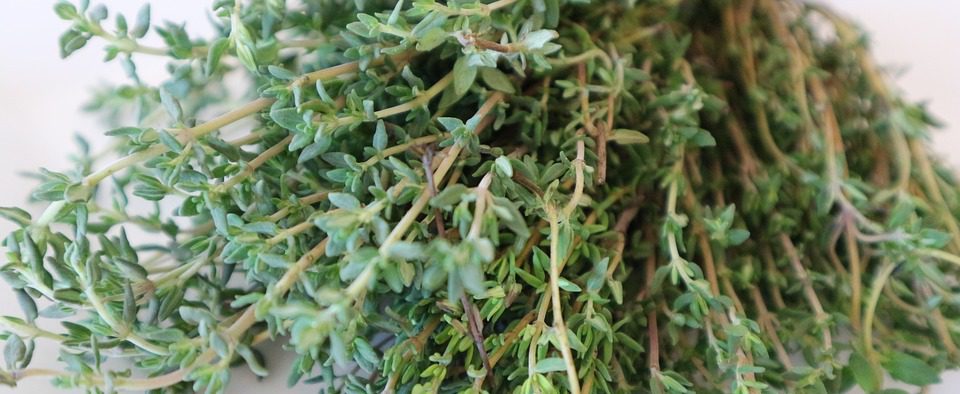
There are many varieties of thyme to suit any person’s taste. From common English thyme, creeping thyme and French Thyme to varieties that smell of citrus or even oregano. Thyme is a perennial herb that is hardy in zones 5-9.
Medical uses – Thymus vulgaris is the most common culinary Thyme. The plant is the principal source of thymol, a volatile oil that is used in medicines as well as perfumes. Before antibiotics bandages were soaked with thymol to cut down on infections. Egyptians used Thyme in embalming. Romans flavored cheeses and liquors with it. It was commonly burned in buildings to purify them.
Herbalists use the flowers, leaves, and oil of thyme digestive complaints such as diarrhea, stomach aches, colic. It is also effective in treating bedwetting. Thyme and its volatile oils are used to arthritis. Thyme is also a constituent of my cough syrup as it helps sore throats and coughs (including whooping cough). It has been traditionally used as a remedy for gas and flatulence and as a diuretic.
Why should you grow medicinal plants?
Growing and using herbs to treat common ailments is a good way to increase self-sufficiency. However, a good, working knowledge of the herbs, their uses, and their counterindications is essential to be effective and avoid problems.
Study the herbs carefully before using and always consult a qualified medical professional before embarking on any self-treatment to any serious illnesses you have.
This article is for educational purposes only and does not substitute for qualified medical care and advice.

What about marijuana?
Thanks for sharing! I know that lemon balm and wormwood are great natural mosquito repellents. The scent of thyme, tansy, lavender can scare those insects off too.